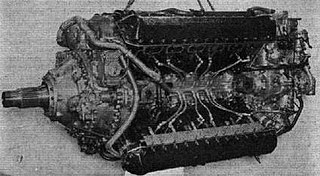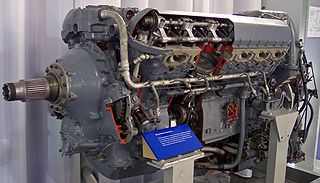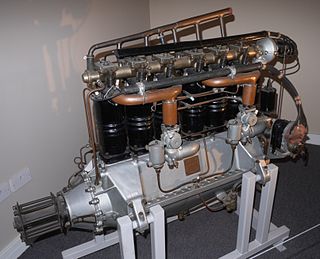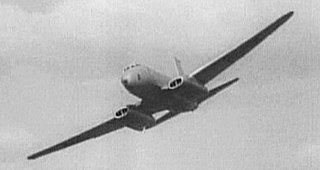
A V12 engine is a twelve-cylinder piston engine where two banks of six cylinders are arranged in a V configuration around a common crankshaft. V12 engines are more common than V10 engines. However, they are less common than V8 engines.

The Rolls-Royce Merlin is a British liquid-cooled V-12 piston aero engine of 27-litre capacity. Rolls-Royce designed the engine and first ran it in 1933 as a private venture. Initially known as the PV-12, it was later called Merlin following the company convention of naming its four-stroke piston aero engines after birds of prey. The engine benefitted from the racing experiences of precursor engines in the 1930s.
The engine configuration describes the fundamental operating principles by which internal combustion engines are categorized.

The Avro 679 Manchester was a British twin-engine heavy bomber developed and manufactured by the Avro aircraft company in the United Kingdom. While not being built in great numbers, it was the forerunner of the famed and vastly more successful four-engined Avro Lancaster, which was one of the most capable strategic bombers of the Second World War.

The Hawker Hart is a British two-seater biplane light bomber aircraft that saw service with the Royal Air Force (RAF). It was designed during the 1920s by Sydney Camm and manufactured by Hawker Aircraft. The Hart was a prominent British aircraft in the inter-war period, but was obsolete and already side-lined for newer monoplane aircraft designs by the start of the Second World War, playing only minor roles in the conflict before being retired.

The Rolls-Royce Vulture was a British aero engine developed shortly before World War II that was designed and built by Rolls-Royce Limited. The Vulture used the unusual "X-24" configuration, whereby four cylinder blocks derived from the Rolls-Royce Peregrine were joined by a common crankshaft supported by a single crankcase. The engine was originally designed to produce around 1,750 horsepower (1,300 kW) but problems with the Vulture design meant that the engines were derated to around 1,450 to 1,550 hp in service by limiting the maximum rpm.

The Rolls-Royce Griffon is a British 37-litre capacity, 60-degree V-12, liquid-cooled aero engine designed and built by Rolls-Royce Limited. In keeping with company convention, the Griffon was named after a bird of prey, in this case the griffon vulture.

The Rolls-Royce Peregrine was a 21-litre (1,300 cu in), 885-horsepower (660 kW) liquid-cooled V-12 aero engine designed and built by the British manufacturer Rolls-Royce in the late 1930s. It was essentially the ultimate development of the company's Kestrel engine, which had seen widespread use in military aircraft of the pre-war period.

The Rolls-Royce Kestrel is a 21.25 litre V-12 aircraft engine from Rolls-Royce. It was their first cast-block engine, and used as the pattern for most of their future piston-engine designs. Used during the interwar period, it was fitted to a number of British fighters and bombers of the era, including the Hawker Fury and Hawker Hart family, and the Handley Page Heyford. The Kestrel engine was also sold to international air force customers; in this role it was used to power prototypes of the German Messerschmitt Bf 109 and the Junkers Ju 87 "Stuka" dive-bomber, as the Junkers Jumo 210 engines were not ready to be fitted. Several examples of the Kestrel engine remain airworthy today.

The Hawker Tornado was a British single-seat fighter aircraft design of the Second World War for the Royal Air Force as a replacement for the Hawker Hurricane. The planned production of Tornados was cancelled after the engine it was designed to use, the Rolls-Royce Vulture, proved unreliable in service. A parallel airframe that used the Napier Sabre engine continued into production as the Hawker Typhoon.

The Rolls-Royce Eagle Mk XXII is a British 24-cylinder, sleeve valve, H-block aero engine of 46 litre displacement. It was designed and built in the early-1940s by Rolls-Royce Limited and first ran in 1944. It was liquid-cooled, of flat H configuration with two crankshafts and was capable of 3,200 horsepower at 18 psi boost.

The Rolls-Royce Crecy was a British experimental two-stroke, 90-degree, V12, liquid-cooled aero-engine of 1,593.4 cu.in capacity, featuring sleeve valves and direct petrol injection. Initially intended for a high-speed "sprint" interceptor fighter, the Crecy was later seen as an economical high-altitude long-range powerplant. Developed between 1941 and 1946, it was among the most advanced two-stroke aero-engines ever built. The engine never reached flight trials and the project was cancelled in December 1945, overtaken by the progress of jet engine development.

Rolls-Royce produced a range of piston engine types for aircraft use in the first half of the 20th century. Production of own-design engines ceased in 1955 with the last versions of the Griffon; licensed production of Teledyne Continental Motors general aviation engines was carried out by the company in the 1960s and 1970s.

The Rolls-Royce Hawk was a British aero engine designed by Rolls-Royce in 1915. Derived from one bank of six cylinders of the Rolls-Royce Eagle, it produced 75 horsepower at 1,370 rpm. Power was progressively increased to 91 hp by February 1916, and 105 hp by October 1918.

The Rolls-Royce Condor aircraft piston engine is a larger version of the Rolls-Royce Eagle developing up to 675 horsepower. The engine first ran in 1918 and a total of 327 engines were recorded as being built.

The Avro 706 Ashton was a British prototype jet airliner made by Avro during the 1950s. Although it flew nearly a year after the de Havilland Comet, it represented an experimental programme and was never intended for commercial use.

A V8 engine is an eight-cylinder piston engine in which two banks of four cylinders share a common crankshaft and are arranged in a V configuration.

The Siddeley Tiger was an unsuccessful British aero engine developed shortly after the end of World War I by Siddeley-Deasy. Problems encountered during flight testing caused the project to be cancelled.

In aviation, an inline engine is a reciprocating engine with banks of cylinders, one behind another, rather than rows of cylinders, with each bank having any number of cylinders, although more than six is uncommon. The major reciprocating-engine alternative configuration is the radial engine, where the cylinders are placed in a circular or "star" arrangement.



















